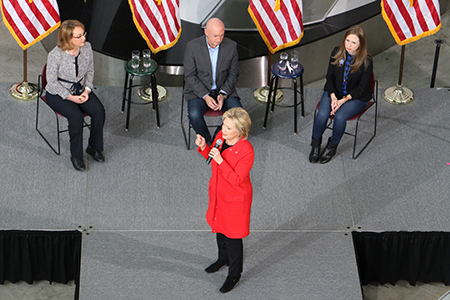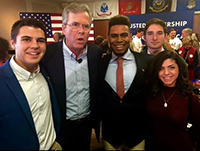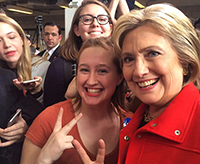Q&A: An Emersonian in Iowa

Hillary Clinton addresses supporters at a rally in Iowa last weekend. Photo/Meaghan Schaefer '19
Emerson College Journalism major Katie Burns ’18 traveled to Iowa last weekend to attend the caucuses and the political events leading up to it.
She went with a group of students majoring in everything from Journalism and Political Communication to Communication Disorders and Performing Arts. The trip was organized by Associate Professor Gregory Payne in the Communication Studies Department.
Emerson College Today asked Burns about her experiences. Responses were edited.
ECT: What did you hope to learn in Iowa?
KB: I hoped to learn how the media covered different candidates (i.e., What I saw vs. what they actually included from politicians’ rallies), as well as how the caucus worked in person.
ECT: What did you actually learn in Iowa?
KB: I definitely learned the first part. Hillary [Clinton] was much more compelling in person than I had seen on TV, as was [Martin] O’Malley. Also, I didn’t see [Donald] Trump, but I heard his rally was surprisingly low energy.
The caucus was largely what I expected, but much more disorganized; each group was much bigger, so it was interesting to see that play out.

Emerson students pose for a photo with Jeb Bush. Left to right, Connor Dane, Niko Emack-Bazelais and Amanda Coscia.
ECT: Which events did you attend?
KB: I attended a Hillary rally, [Marco] Rubio rally, [Carly] Fiorina town hall, O’Malley house party, [Chris] Christie town hall, [Ted] Cruz rally, and the caucus itself. I also canvassed for Hillary.
ECT: How did the Democratic events compare to the Republican events?
KB: It’s easier to compare by voter turnout than by candidate. Those with celebrity status essentially (Hillary, Bernie, Cruz) had much larger rallies with music, opening speakers to pump the crowd up, etc. The main difference I saw there was that Cruz immediately jumped down from the stage to interact with the crowd, while Bernie and Hillary both had physical barriers between them and the crowd.
The smaller events were much more intimate. At the O’Malley house party, everyone got one-on-one time with him, as with Fiorina, and with Christie.
ECT: What caucus(es) did you attend, and was it what you expected?
KB: I attended two Democratic caucuses—one precinct with almost entirely students, another with those from the surrounding area (I’m assuming). Both were very disorganized, but the student one was almost entirely Bernie supporters, which I wasn’t necessarily expecting. He ended up winning 100% of the precinct because neither O’Malley nor Hillary were viable.
Hillary supporters were upset because the room was too small, so they were put across the hall. And though they got to speak, they had a harder time lobbying because they weren’t physically in the same room. It was also easy to see how miscounts could happen because people were coming and going and switching sides, and everyone assumed we were voters even though we were visitors.

Emerson student Marion Kinosian and Hillary Clinton use a little sign language in Iowa.
ECT: Were you surprised by the outcomes at all?
KB: The Republican side was pretty much exactly what I was expecting. But I did not expect it to be so close between Bernie and Hillary. I expected it to be close, but not that close.
ECT: Who had the most intense supporters?
KB: Of the events I saw, Cruz, definitely, but I heard the Bernie crowd was pretty intense.
Categories